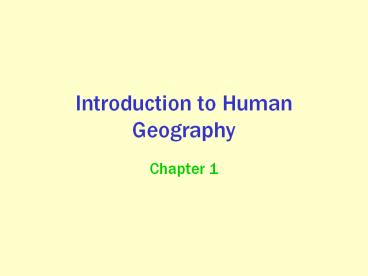Introduction to Human Geography - PowerPoint PPT Presentation
Title:
Introduction to Human Geography
Description:
Introduction to Human Geography Chapter 1 What is Human Geography? Human Geography The study of how people make places, how we organize space and society, how we ... – PowerPoint PPT presentation
Number of Views:507
Avg rating:3.0/5.0
Title: Introduction to Human Geography
1
Introduction to Human Geography
- Chapter 1
2
Human Geography
- The study of how people make places, how we
organize space and society, how we interact with
each other in places and across space, and how we
make sense of others and ourselves in our
locality, region, and world.
3
Geographers use fieldwork to understand linkages
among places and to see the complexities of issues
- Why do Kenyans grow tea and coffee instead of
cash crops?
4
Globalization
- A set of processes that are
- increasing interactions
- deepening relationships
- heightening interdependence
- without regard to
- country borders.
- A set of outcomes that are
- unevenly distributed
- varying across scales
- differently manifested
- throughout the world.
5
Imagine and describe the most remote place on
Earth you can think of 100 years ago. Now,
describe how globalization has changed this place
and how the people there continue to shape the
place to make it the place it is today.
6
(No Transcript)
7
What are Geographic Questions?
Key Question
8
Geographic inquiry focuses on the spatial
- - the spatial arrangement of places
- and phenomena (human and
- physical).
- - how are things organized on Earth?
- - how do they appear on the landscape?
- - why? where? so what?
9
Spatial distribution
- What processes create and sustain the pattern of
a distribution?
Map of Cholera Victims in Londons Soho District
in 1854. The patterns of victims homes and
water pump locations helped uncover the source of
the disease.
10
Five Themes of Geography
- Location
- Human-Environment
- Region
- Place
- Movement
11
Place
- Sense of place infusing a place with meaning and
emotion. - Perception of place belief or understanding of
what a place is like, often based on books,
movies, stories, or pictures.
12
Movement
- Spatial interaction the interconnectedness
between places depends upon - Distance
- Accessibility
- Connectivity
13
Cultural Landscape
- The visible human imprint on the landscape.
Religion and cremation practices diffuse with
Hindu migrants from India to Kenya.
14
Sequent Occupance
- Dar es Salaam, Tanzania
- African, Arab, German, British, and Indian layers
to the city.
Apartment in Mumbai, India
Apartment in Dar es Salaam, Tanzania
15
Why do Geographers use Maps, and What do Maps
Tell Us?
Key Question
16
Two Types of Maps
- Reference Maps
- Show locations of places and geographic features
- Absolute locations
- What are reference maps used for?
- Thematic Maps
- Tell a story about the degree of an attribute,
the pattern of its distribution, or its movement. - Relative locations
- What are thematic maps used for?
17
Reference Map
18
Thematic Map
What story about median income in the Washington,
DC area is this map telling?
19
- Mental Maps
- maps we carry in our minds of places we have
been and places we have heard of. - can see terra incognita, landmarks, paths,
- and accessibility
- Activity Spaces
- the places we travel to routinely in our rounds
of daily activity. - How are activity spaces and mental maps
related?
20
- Geographic
- Information
- System
- a collection of
- computer hardware
- and software that
- permits storage and
- analysis of layers of
- spatial data.
21
Remote Sensing a method of collecting data by
instruments that are physically distant from the
area of study.
22
Why are Geographers Concerned with Scale and
Connectedness?
Key Question
23
Scale
- Scale is the territorial extent of something.
- The observations we make and the context
- we see vary across scales, such as
- - local
- - regional
- - national
- - global
24
Scale
25
Regions
- Formal region defined by a commonality,
typically a cultural linkage or a physical
characteristic. - e.g. German speaking region of Europe
- Functional region defined by a set of social,
political, or economic activities or the
interactions that occur within it. - e.g. an urban area
26
Regions
- Perceptual Region ideas in our minds, based on
accumulated knowledge of places and regions, that
define an area of sameness or connectedness. - e.g. the South
- the Mid-Atlantic
- the Middle East
27
(No Transcript)
28
Culture
- Culture is an all-encompassing term that
identifies not only the whole tangible lifestyle
of peoples, but also their prevailing values and
beliefs. - - cultural trait
- - cultural complex
- - cultural hearth
29
Connectedness
- Diffusion the process of dissemination, the
spread of an idea or innovation from its hearth
to other areas. - What slows/prevents diffusion?
- - time-distance decay
- - cultural barriers
30
Types of Diffusion
- Expansion Diffusion idea or innovation spreads
outward from the hearth - Contagious spreads adjacently
- Hierarchical spreads to most linked people or
places first. - Stimulus idea promotes a local experiment or
change in the way people do things.
31
(No Transcript)
32
Stimulus Diffusion
Because Hindus believe cows are holy, cows often
roam the streets in villages and towns. The
McDonalds restaurants in India feature veggie
burgers.
33
Types of Diffusion
- Relocation diffusion movement of individuals
who carry an idea or innovation with them to a
new, perhaps distant locale.
Paris, France
Kenya
Photo credit A.B. Murphy
Photo credit H.J. de Blij































